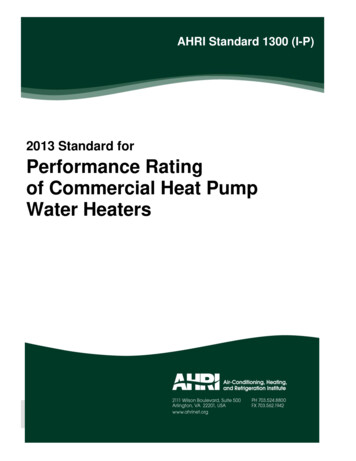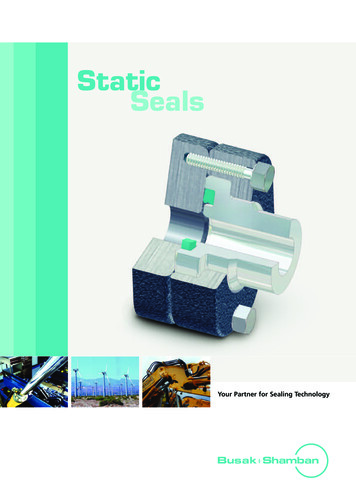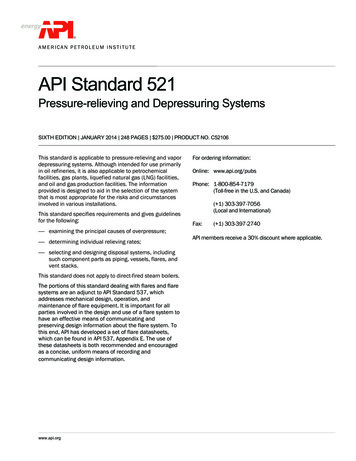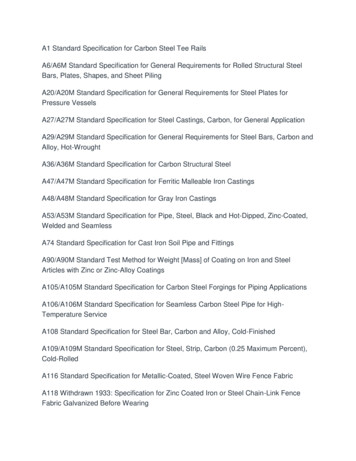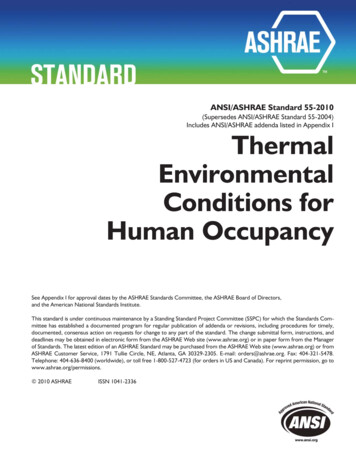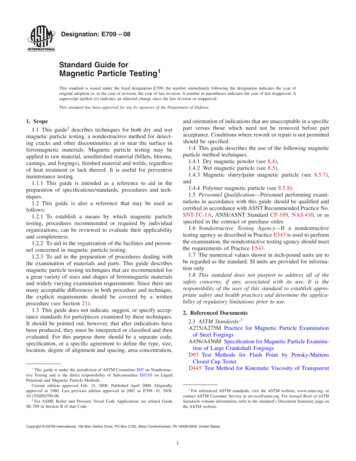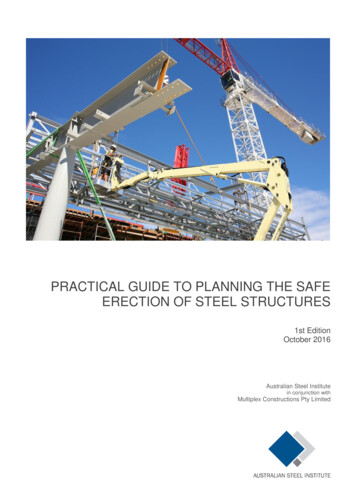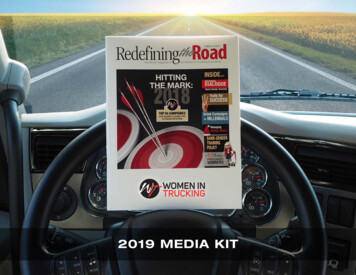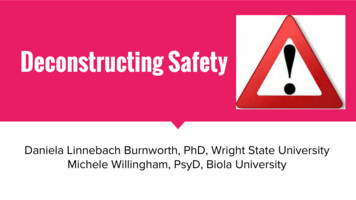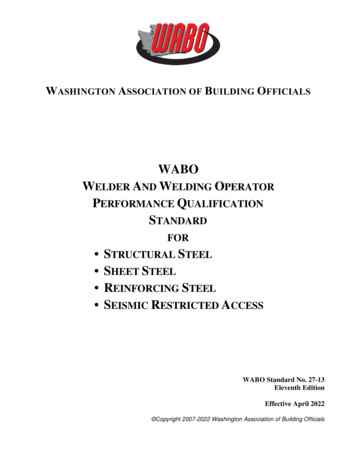
Transcription
WASHINGTON ASSOCIATION OF BUILDING OFFICIALSWABOWELDER AND WELDING OPERATORPERFORMANCE QUALIFICATIONSTANDARDFOR STRUCTURAL STEELSHEET STEELREINFORCING STEELSEISMIC RESTRICTED ACCESSWABO Standard No. 27-13Eleventh EditionEffective April 2022 Copyright 2007-2022 Washington Association of Building Officials
2
FOREWARDThis eleventh edition of the Welder and Welding Operator Performance Qualification Standard No. 27-13updates and replaces previous editions of this Standard and reflects the applicable requirements and intentof most recent editions of the Washington State Building Code; Structural Welding Code-Steel(ANSI/AWS D1.1); Structural Welding Code – Seismic Supplement (ANSI/AWS D1.8); StructuralWelding Code-Sheet Steel (ANSI/AWS D1.3) and the Structural Welding Code-Reinforcing Steel(ANSI/AWS D1.4).This Standard has been compiled through the joint efforts of members of the Washington Association ofBuilding Officials (WABO) and members of the American Welding Society (AWS).Acknowledgements:A special thank you to the WABO Welder Advisory Board members for their contributions in preparingthis standard. Contributing members:Brian Smith, CBO, ACO - City of BellevueDave Barnes, Barnes WeldingEddie Sanchez, Ironworkers Local #86Michael Hayes, AeroWelding, LLCMichael Mayes, PE – Mayes Testing Engineers Inc.,A Terracon CompanyJohn Loscheider, PE – Loscheider Engineering Co.David Parker, WA Welding Instructors GroupJay Ponce – WABO Technical ConsultantGary Schenk – WABO Technical ConsultantThis Standard has been published as follows:1st edition November 19802nd edition May 19823rd edition May 19894th edition October 20025th edition July 20086th edition November 20137th edition December 10, 20148th edition December 20179th edition January 201910th edition February 202011th edition April 2022Washington Association of Building OfficialsPO Box 7310Olympia, Washington 98507-7310(360) 628-8669Fax: 360-918-8021E-mail: wabo@wabo.orgWeb page: www.wabo.org3
PREFACEThe Washington Association of Building Officials (WABO) is a nonprofit corporation established toresearch, develop, and promote the uniform implementation and enforcement of building codes in theState of Washington. The Association’s membership includes building officials from jurisdictions at alllevels (state, county, city, and town) who are responsible for administering and enforcing building codes.Building codes adopted within the State of Washington include requirements for qualifications of welders.To provide greater confidence in compliance with these requirements, WABO Standard 27-13 establishesuniform qualification and testing procedures for certification of welders, welding operators, and tackers.4
TABLE OF pe .627-13.3Welder Qualifying Agency Requirements .627-13.4Welder Certification.827-13.5Welder Qualification General Requirements .1027-13.6Welder Qualification Tests .1127-13.7Qualification Tests Required and Limitations .1427-13.8Visual Inspection Criteria for Acceptance .1527-13.9Test Specimens, Root, Face, or Side-bend .1627-13.10Methods of Testing Specimens .1627-13.11Technical Inquiries.1827-13.12Challenges and Appeals .1927-13.13Suspension and Withdrawals .19List of Figures .20List of Tables .4927-13-QTerms and Definitions.60Sample Welding Procedure Specifications.695
SECTION 27-13.1 - PURPOSEThe purpose of this Standard is to provide greater confidence to design professionals, owners, and buildingofficials that welders, welding operators, and tackers are qualified to perform the work for which theyhave been certified for building construction.Certification of personnel in accordance with this Standard is intended to be part of an overall weldingquality assurance program. Other components of welding quality assurance may include but are notlimited to the following: Approved construction documents Contractor quality control Approved welding procedures Welder qualifications not covered by this Standard Material testing Building department inspections Special inspections Structural observationThe qualification tests described in this Standard are not intended to be used as a guide for welding duringactual construction, and certification of personnel in accordance with this Standard shall not be used as asubstitute for other requirements of welding quality assurance.SECTION 27-13.2 – SCOPEThe provisions of this Standard shall apply to the qualification and certification of welders, weldingoperators and tackers performing structural steel, sheet steel, seismic, and reinforcing steel welding. Thelimitations of welder and welding operator qualifications are found in Table 27-13-I.SECTION 27-13.3 - WELDER QUALIFYING AGENCY REQUIREMENTS1. GENERALOnly WABO Approved Welder Examiners employed at WABO Welder Qualifying Agencies areauthorized to perform the welder and welding operator performance qualification tests required by thisStandard at WABO approved facilities.Welder Qualifying Agencies interested in becoming approved by WABO to perform the tests may obtainapplication forms and information concerning certification by contacting the WABO office or by visitingthe WABO website at www.wabo.org.6
2. ELIGIBILITYThe following organizations are eligible to become approved WABO Welder Qualifying Agencies:2.1 Independent testing laboratories2.2 Private and public welder vocational training institutions, including those operated by laborunions2.3 Steel fabricator plants certified by the AISC Quality Certification Program2.4 Others granted approval by WABO3. INSPECTION-EVALUATIONInspection-Evaluation of welder qualifying agencies will be performed by one or more personsselected by WABO who are knowledgeable in welding and welder qualification. The agency willreceive a technical survey of its testing facility and methods of record keeping.4. CERTIFICATION OF WELDER QUALIFYING AGENCIESUpon recommendation for certification by the Inspection-Evaluation team, WABO will issuecertificates identifying the agency and its key personnel. The agency certificate will be valid for athree-year period, subject to periodic re-inspections of the agency.5. AGENCY PERSONNELAgency personnel witnessing the tests and approving the mechanical and visual test coupons must beWABO Approved Welder Examiners. Agency personnel can become WABO Approved WelderExaminers by submitting proof that they are an AWS Certified Welding Inspector (CWI) qualifiedand certified in accordance with the provisions of AWS QCI, Standard for Qualification andCertification of Welding Inspectors and successfully completing the WABO written WelderExaminer Test based on the contents of this Standard. Upon successful completion of the writtenexam, an Approved Welder Examiner card will be issued. Examiner cards are valid for one year andare required to be renewed annually.Personnel performing radiographic testing will be qualified in accordance with the current edition ofthe American Society for Nondestructive Testing Recommended Practice No. SNT-TC-1A. Onlyindividuals qualified for NDT Level II may perform and interpret radiographic testing.7
SECTION 27-13.4 - WELDER CERTIFICATIONWelders and welding operators may become certified by WABO in one or more of the followingcategories and processes by satisfactory completion of the applicable qualification tests described inthis Standard.Following are the welder certification classifications available through the WABO WelderCertification Program.1. Structural WelderProcessMethodShielded Metal Arc Welding (SMAW)Gas Tungsten Arc Welding (GTAW)Gas Metal Arc Welding (GMAW)Flux Cored Arc Welding (FCAW)ManualManualSemi-automaticSemi-automatic2. Sheet Steel WelderProcessMethodShielded Metal Arc Welding (SMAW)Gas Tungsten Arc Welding (GTAW)Gas Metal Arc Welding (GMAW)Flux Cored Arc Welding (FCAW)ManualManualSemi-automaticSemi-automatic3. Welding OperatorProcessMethodSubmerged Arc Welding (SAW)Automatic4. Reinforcing Steel WelderProcessMethodShielded Metal Arc Welding (SMAW)Gas Metal Arc Welding (GMAW)Flux Cored Arc Welding (FCAW)ManualSemi-automaticSemi-automatic5. Seismic Restricted Access Welder(Prerequisite: WABO Certification for Field Structural Welder in applicable process)ProcessMethodShielded Metal Arc Welding (SMAW)Flux Cored Arc Welding (FCAW)8ManualSemi-automatic
6. WELDER CERTIFICATION CARDS6.1Welder certification cards are the property of WABO and issued to the certified welder tokeep in their possession for a period of one year. For certifications to remain valid, the weldermust have the certificate endorsed by his/her supervisor or designee, or by a WABO ApprovedWelding Examiner. The endorser shall have witnessed the individual's welding during thecalendar quarter being endorsed.6.2 To renew the certification, the welder shall submit properly endorsed signature form to WABOand pay a renewal fee.6.3 The qualification of the welder or welding operator shall remain in effect indefinitely unless:6.3.1The welder or welding operator is not engaged in the weld process for which he/she isqualified for a period exceeding six (6) months, in which case a new qualification testshall be required.6.3.2There is some specific reason to question a welder or welding operator's ability, inwhich case, a new qualification test may be required. In the event the welder or weldingoperator fails to pass the new qualification test, certification shall be suspended untilhe/she can successfully complete the welding test.6.3.3The welder fails to renew his/her certification on or before the expiration date.EXCEPTION: An expired certification may be reinstated within sixty (60) days afterthe expiration date. Thereafter, a new qualification test shall be required.6.3.4Certification for Seismic Restricted Access Welder shall remain valid for 36 months,providing the continuity requirements for process use outlined above are met. After 36months a new qualification test is required.6.4 Welder Certification RevocationEach certification card carries the statement “This card is the property of WABO,” which entitlesall possession rights to WABO, thereby extending authority beyond the officers, executive boardand program managers to any representative acting on behalf of WABO, i.e. building officials,inspectors, and examiners to confiscate any certification card for probable cause. Confiscatedcertification cards must be forwarded to the WABO office, accompanied by a written explanationof circumstances, within five (5) working days of the infraction date.Any Certificate issued by WABO for certification and registration programs presented asqualification by an individual:6.4.1Other than the certificate holder, for any reason, will deem any and all WABOcertificates held by the certificate holder revoked for a period of not less than three (3)years from the date of infraction.6.4.2The person presenting another certificate holders certificate, for any reason, will alsoautomatically have any and all WABO certificates revoked for a period of not less thanthree (3) years from the date of infraction.9
6.4.3If the person presenting another individual’s certificate is not currently certified byWABO, that person will be prohibited from obtaining any WABO certification for aperiod of not less than three (3) years from the date of infraction.6.4.4Altered certificates, other than those approved and currently on file at WABO carry thesame three (3) year revocation provision.Section 27-13.5 - WELDER QUALIFICATION GENERAL REQUIREMENTS1. KNOWLEDGE AND ABILITY1.1Work Performance. Each welder and welding operator shall perform one or more test weldson prepared test coupons in accordance with the following:1.1.1Welding machines shall be set at zero or minimum setting prior to the welder orwelding operator adjusting the machine.1.1.2Prior to welding, each test weldment shall be identified by placing a welder or weldingoperator identification mark and laboratory test number on the test weldment for eachprocess and position.1.1.3Each specimen removed from the test weldment shall be stamped with laboratory testnumber and specimen number.1.1.4Test weldments may not be removed from position during the test.1.1.5Cleaning and removal of slag, undercut and excess bead convexity between passes isacceptable if made in position with the approval of the Welder Examiner.1.1.6Grinding of root and cover passes not permitted.1.1.6.1 Root pass grinding on pipe is acceptable with permission of the WelderExaminer.2. RECORDSA complete record shall be made of the tests performed by each welder or welding operator, and ofthe results of those tests.Original copies shall be forwarded by the Welder Examiner to the WABO office within thirty (30)days, together with the application and processing fee.A copy of each record shall be kept by the Welder Examiner, at the qualifying agency, for a periodof three (3) years. Bend test specimens and radiographic specimens shall be retained by the WelderExaminer, at the qualifying agency, for a period of six (6) months. Copies of radiograph reports shallbe forwarded to the WABO office with the original record. The original copies of the tests shall bekept for current welders at the WABO office indefinitely.10
Certificates shall be issued by the WABO office. A roster of currently certified welders andwelding operators shall be kept at the WABO office.Records and specimens shall be available to those authorized by WABO to examine them. Visualspecimens and bend specimens shall be maintained securely fastened together with identificationstamping clearly visible.Section 27-13.6 - WELDER QUALIFICATION TESTS1. QUALIFICATION TEST FOR STRUCTURAL WELDERSThe welder qualification test for manual and semi-automatic welding shall be one of the following:1.11.21.31.4Groove weld test for plate of unlimited thickness.Groove weld test for plate of limited thickness.Groove weld test for butt joints on pipe or square or rectangular tubing of unlimitedthickness.Groove weld test for T-, K-, or Y-connections on pipe or tubing of unlimited thickness.2. QUALIFICATION TEST FOR SHEET STEEL WELDERS (See Figure 27-13.09.7)The welder qualification test for Sheet Steel welding shall be a fillet welded T-joint test (sheet tosupporting member).3. QUALIFICATION TEST FOR WELDING OPERATOR (See Figure 27-13.09.8)The welding operator qualification test shall be a groove weld test on plate.4. QUALIFICATION TEST FOR REINFORCING STEEL WELDERS (See Figure 27-13.09.9)The welder qualification test for reinforcing steel welders shall be a flare bevel groove indirect buttjoint.5. SUPPLEMENTARY QUALIFICATION TEST FOR SEISMIC RESTRICTED ACCESSWELDER5.1 GeneralThis test is used to qualify welders for flat position groove welding. Backgouging is part of thistest when steel backing is used and required to be removed. It is also used to qualify welderswhen non-steel backing is used, or when open root groove welds are used. WABO Certificationfor Field Structural Welding in applicable process is a prerequisite.5.2 Test Plate ConfigurationThe test plate configurations and dimensions shall be as shown in Figure 27-13.14.1 or Figure27-13.14.2, and Figure 27-13.14.3 as applicable.11
5.3 Test Plate Fabrication5.3.1 General Requirements5.3.1.1 Test Plate AssemblyThe parts for the test plate assembly may be cut and tack welded together by anindividual other than the welder performing the qualifications test, except that thewelder being qualified shall attach the required weld tabs.5.3.1.2 Welding Procedure SpecificationThe test plate assembly shall be welded in accordance with a WPS using the processfor which the welder is being qualified. The combination of variables shall be suchthat the deposition rate used in the qualification test is equal to or greater than thehighest deposition rate that will be used in production.5.3.2 Additional Requirements for Option AOption A shall be used to qualify welders to use steel backing.5.3.2.1 Steel BackingThe steel backing shall be a minimum thickness of ¼ in. (6 mm), and a maximumof ¾ in. (18 mm), and shall be at least 1 in. (25 mm) wide. Backing width shouldbe at 3 in. wide if radiography will be used to evaluate weld. The backing shall beattached to the test plate assembly with tack welds.5.3.2.2 Groove Weld DetailThe groove weld detail shall use a 3/8 in. (6 mm) root opening, /- 1/16 in. (1.5mm). The included angle shall be 30 degrees, /- 5 degrees.5.3.3 Option A LimitationsWelders qualified in accordance to Option A shall be permitted to weld on any joint thatuses steel backing. Separate qualification shall be required if the type of backing ischanged (e.g., a change from steel to ceramic, or from steel backing to open root joints,etc.).5.3.4 Additional Requirements for Option BOption B shall be used to qualify welders for the use of other than steel backing, includingthe use of ceramic or copper backing, or open root welding.5.3.5 Backing RemovalAfter the groove weld has been completed, the non-steel backing (if used) shall be removedby the welder being qualified.12
5.3.6 Backgouging and Backwelding.Removal shall be done in the overhead position. The root of the weld shall bebackgouged to sound metal. The backgouged cavity shall be backwelded. Thebackwelding shall be performed in the overhead position. The welding process for theoverhead welding need not be the same as that used for the flat position welding. Thedepth of the backgouging shall not exceed ¼” (6 mm).5.3.7 Option B LimitationsWelders qualified in accordance to Option B shall be qualified to use the specific backingtype used during the test. Root openings shall be no greater than that used in the welderqualification test. Separate qualifications shall be required if the type of backing ischanged (e.g., a change from copper to ceramic, or copper to steel, etc.).5.4 Specimen Testing5.4.1 Visual InspectionAfter removal of the web plate, column plate and attachment plate, the weldment shall bevisually inspected.5.4.2 Additional TestingThe test plate shall be subject to one of the following tests, at the option of the WABOExaminer:(1) Bend tests (See Section 27-13.11.7)(2) RT inspection5.4.2.1 Bend Tests5.4.2.1.1 Specimen LocationsThe flat test plate shall be cut to prepare four transverse side-bend tests, witheach test sample 3/8 inch (10 mm) thick. Two side-bend specimens shall befrom the region that was under the 1 inch (25 mm) web plate. Two side bendsshall be taken from within ¼ inch (6 mm) of the ends of the welds. The sideof the specimen nearest to the end of the weld shall be clearly marked.5.4.2.1.2 Specimen Testing ProcedureFor the two specimens taken from the ends of the weld, the specimens shallbe bent so that the side of the bend specimen that was nearest to the end ofthe weld becomes the convex side of the bend specimen (e.g., sees the greatesttension).6. RETESTIn case a welder or welding operator fails to meet the requirements of one or more test welds, a retestmay be allowed under the following conditions:6.1An immediate retest within seven (7) days of notification of failure. The retest shall consist oftwo test welds of each type in each position on which the welder or welding operator failed.13
6.2A subsequent retest may be made provided the welder or welding operator submitsdocumented proof of eight (8) hours minimum further training or practice, in which case asingle retest weld of each type and position failed shall be made.Section 27-13.7 - QUALIFICATION TESTS REQUIRED AND LIMITATIONS1. General NotesField qualification qualifies for shop, but shop qualification does not qualify for field.Qualified thickness range and positions are shown on Tables 27-13-A through H. The limitations ofthese certifications are shown on Table 27-13-I.A welding operator qualified with an approved electrode and shielding medium combination shall beconsidered qualified to weld with any other approved electrode and shielding medium combinationfor the process used in the procedure qualification test.For structural and reinforced steel qualifications, vertical position welding progression shall beupwards.For each weld process (SMAW, GMAW, FCAW, GTAW, SAW) for which certification is required,test plates or pipe shall be welded using any of the structural steels listed in Table 27-13-J using theelectrodes, positions and plate or pipe thicknesses in Tables 27-13-A through E.For sheet steel welder qualifications, T-joint test plates shall be welded using one of the sheet steelslisted in Table 27-13-K using electrodes and positions shown in Tables 27-13-F and 27-13-G. ForSMAW, GMAW, and FCAW, Sheet Steel qualification test qualifies welder for both galvanized anduncoated steel. For GTAW, the Sheet Steel Qualification test qualifes the welder for uncoated steelonly.For reinforcing steel welder qualifications No. 4 ASTM A706 bars shall be welded to any of thestructural steels listed in Table 27-13-J with the electrodes and in the positions shown on Table 2713-H. Two (2) test assemblies are required.The welder shall be certified for the welding process and method used in qualification tests only(SMAW, GMAW, GTAW, FCAW, and SAW). Certifications for all others are not covered by thisStandard.Welder shall be qualified to weld all filler metals of the same designation and lower strength than thatused in the test (F4 and lower for SMAW process). See Table 27-13-L.Upgrading from shop to field certifications do not need to be administered by the same examiner orthe same WABO testing agency.14
SECTION 27-13.8 - VISUAL INSPECTION CRITERIA FOR ACCEPTANCEAll welds shall be visually inspected. The root pass shall be visually inspected and approved by theWABO Approved Welder Examiner prior to continuation. Final visual inspection of welds may beginimmediately after the completed welds have cooled to ambient temperature.1. PLATE AND REINFORCING STEEL WELDSA weld shall be acceptable by visual inspection if it shows the following:1.1The weld has no cracks or arc strikes outside the weld area.1.2Thorough fusion exists between adjacent layers of weld metal and between weld metal andbase metal.1.3All craters are filled to the full cross section of the weld.1.4Weld profiles are in accordance with Section 27-13.8.4.1.5Undercut is no more than 1/32 " deep, nor exceeds ten percent (10%) of the test weld length.1.6The piping porosity does not exceed one pore.1.7Welds are started and terminated at the end of a joint in a manner that will insure sound welds.2. PIPE AND TUBING WELDSA pipe weld shall be acceptable by visual inspection if it shows the following:2.1The weld has no cracks or arc strikes outside the weld area.2.2All craters are filled to the full cross section of the weld.2.3The face of the weld is at least flush with the outside surface of the pipe, and the weld is mergedsmoothly with the base metal. Undercut shall not exceed 1/32" and weld reinforcement shallnot exceed the following:Pipe Wall Thickness(Inches)Reinforcement, Maximum(Inches)3/8 or less3/8 to 3/4 incl.Over 3/43/321/83/1615
2.4There is no evidence of cracks, incomplete fusion, or inadequate joint penetration in the root.A concave root surface is permitted, within the limits of Section 27-13.8.2.2.5, below, providedthe total weld thickness is equal to or greater than that of the base metal.2.5The maximum root surface concavity is 1/16 ", and the maximum melt-through is 1/8 inch.3. SHEET STEEL FILLET WELDSA fillet weld shall be acceptable by visual inspection if it is reasonably uniform in appearance and isfree of overlap, cracks, and excessive undercut.4. ACCEPTABLE AND UNACCEPTABLE WELD PROFILESGroove welds shall preferably be made with slight or minimum reinforcement. The reinforcementshall not exceed 1/8 inch in height and shall have gradual transition to the plane of the base metalsurface (see Figure 27-13.10.1). Welds shall be free of the discontinuities shown for butt joints (SeeFigure 27-13.10.2).Section 27-13.9 - TEST SPECIMENS, ROOT-, FACE-, OR SIDE-BEND1. TYPE AND NUMBERThe type and number of test specimens that must be mechanically tested to qualify a welder whenradiographic testing is not used are shown in Figures 27-13-11.1 through 11.9.Section 27-13.10 – METHODS OF TESTING SPECIMENS1. ROOT-, FACE-, OR SIDE-BEND TEST AND EVALUATIONThe entire length of the groove weld shall be examined visually prior to cutting specimens.Each specimen shall be bent in a jig having the contour shown in Figure 27-13-12.1 and otherwisesubstantially in accordance with that Figure. Any convenient means may be used to move the plungermember with relation to the die member.The specimen shall be placed on the die member of the jig with the weld at midspan.Root-bend specimens shall be placed with the root of the weld directed toward the die member.Face-bend specimens shall be placed with the face of the weld directed toward the die member.Side-bend specimens shall be placed with that side showing the greater discontinuity, if any, directedtoward the die member.The plunger member shall force the specimen into the die member until the specimen becomesU-shaped. The weld and heat-affected zones shall be centered and completely within the bent portionof the specimen after testing.16
The convex surface of the bend test specimen shall be visually examined for surface discontinuities.For acceptance, the surface shall contain no discontinuities exceeding the following dimensions:1.1 1/8 inch - measured in any direction on the surface1.23/8 inch - the sum of the greatest dimensions of all discontinuities exceeding 1/32 inch, but lessthan or equal to 1/8 inch1.31/4 inch - the maximum corner crack, except when that corner crack resulted from visible slaginclusion or other fusion type discontinuities, then the 1/8 inch maximum shall apply. Specimenswith corner cracks exceeding 1/4 inch with no evidence of slag inclusions or other fusion typediscontinuities shall be disregarded, and a replacement test specimen from the original weldmentshall be tested2. SHEET STEEL FILLET WELD BREAK TEST AND EVALUATIONThe entire length of the fillet weld (see Figure 27-13-12.2) shall be examined visually and then the 5inch long specimen shall be loaded in such a way that the root of the weld is in tension. The loadshall be steadily increased or repeated until the specimen fractures, or bends flat upon itself.The specimen shall pass the test if it bends flat upon itself or, if the fillet weld fractures, the fracturedsurface shows complete fusion to the root of the joint.3. REINFORCING STEEL WELD TEST AND EVALUATIONThe entire length of the flare bevel groove welds shall be visually examined. Then each test assemblyshall be mechanically cut at two locations to provide two transverse cross sections of each weldassembly.A macrotech test shall be performed by polishing and etching cross sections with a suitable solutionto give a clear definition of the weld. The etched cross section shall show the minimum designatedeffective weld size for the flare groove test assemblies. (See Figure 27-13.09.9)4. RADIOGRAPHIC TESTINGRadiographic examination of the welder or welding operator test plate may be made in lieu of a bendtest.If radiographic testing is used in lieu of the prescribed bend tests, the weld reinforcement need not beground or otherwise smoothed for inspection unless its surface irregularities or juncture with the basemetal would cause objectionable weld discontinuities to be obscured in the radiograph. If the backingis removed for radiography, the root shall be ground flush with the base metal.Exclude 1-1/4 inch at each end of the weld from evaluation in the plate test for welder qualificationand exclude three (3) inches at each end of the length of the test plate for welding operatorqualification.17
Welded test pipe shall be examined for a minimum of one-half of the weld perimeter selected toinclude a sample of all positions welded. (For example, a test pipe or tube welded in the 5G, 6G or6GR position shall be radiographed from the top center line to the bottom center line on either side.)The radiographic procedure and technique shall be in accordance with the current requirements ofANSI/AWS D1.1.For acceptable qualification by the radiograph, the weld shall have no cracks and shall conform to thefollowing:4.1The greatest dimension of any porosity or fusion-type discontinuity that is 1/16 inch or largerin greatest dimension shall not exceed size (B), indicated in Figure 27-13-13.1 for the effectivethroat or weld size involved. The d
This eleventh edition of the Welder and Welding Operator Performance Qualification Standard No. 27-13 . Gas Metal Arc Welding (GMAW) Semi-automatic Flux Cored Arc Welding (FCAW) Semi-automatic 5. Seismic Restricted Access Welder (Prerequisite: WABO Certification for Field Structural Welder in applicable process) .
